Shed Paint or Wood Stain? Deciding on the Best Protection for Your Shed Cladding
Shed paint or wood stain, that is the question. Well, you're not alone. Many homeowners face this quandary when looking to protect their beloved storage havens and enhance their aesthetic appeal. The purpose of this article to is help you to understand the difference between the two and to know when to use each one.
At the end of the article I hope that you will BEE as happy as this chap!
 Shed painted with contrasting colours
Shed painted with contrasting colours
Have you ever wondered why we frequently paint timber, apart from improving its appearance?
The three principal reasons are:
As a protection against deterioration due to weathering - the main factors of weathering are UV damage to the surface of the wood and water absorption. Splitting, distortion and greying of the wood surface.
Control against dimensional change - Dimensional change is particularly important with items of joinery such as windows and doors.
Protection against blue stain attack - By excluding moisture and air the timber is protected against disfigurement by blue stain.
The most common method of addressing all of the above is to coat the timber with paint or woodstain. Both of these are liquids and generally come supplied in tins. But they work in quite distinct ways and it is worth taking time to understand them so that you can best protect your s hed from the elements.
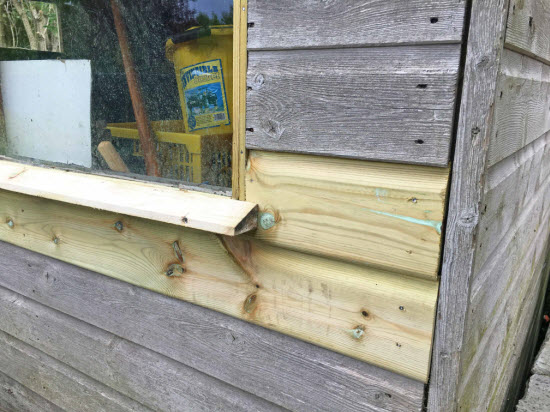 This shed had never had a protective coating and needed repair around the window corners
This shed had never had a protective coating and needed repair around the window corners
What is the physical difference between Paint and Wood Stain?
Let's start by getting to know the contents of each.
Wood paint primarily includes pigments for colour, binders to hold the pigment together and make it stick to surfaces, and solvents to maintain liquid consistency. Paint manufacturers have huge control over the properties of paint by using proprietary additives. These additives give them control over properties such as durability, drying time, and resistance to environmental factors.
The result is an impervious protective layer, approximately 60 to 100 micron thick, on your shed cladding, creating a solid color finish
Wood stain, on the other hand is mainly composed of colorants and a carrier. The colorants, often dye or pigments, provide the desired hue, while the carrier, which can be water, oil, or alcohol, helps to with the penetration of the colorants into the wood fibres.
The wood stain seeps into the timber, and becomes part of the surface, but still has a thickness on the surface of the timber of between 20 and 60 microns. It allows the natural wood grain of your shed, to be in the limelight while adding a hint of color.
Delving into the Pros of Paint
The main advantage of paint is that it forms a flexible film that adheres to the surface of the wood. This film protects the underlying wood from damage due to UV light and protects the wood from rain and snow. So, keeping the wood dimensional stable.
The pigments in paint mean that it great for providing a huge array of colour options from classic neutrals to bold pops.
 Brightly coloured beach huts
Brightly coloured beach huts
Plus, thanks to the smooth finish of paint, your walls become a breeze to clean.
The Cons of Using Paint on Your Shed
The main disadvantage is that over time the impervious layer that sits on the surface of the wood is prone to damage. It may be due to impact damage, there may be bubbles due to problems with application or cracking due to age and the toll of UV from the sun and thermal changes over the years. The issue is that once this protective layer is broken water can get through and find it difficult to escape. When water is trapped in the fabric of the wood it allows the process of timber decay to begin.
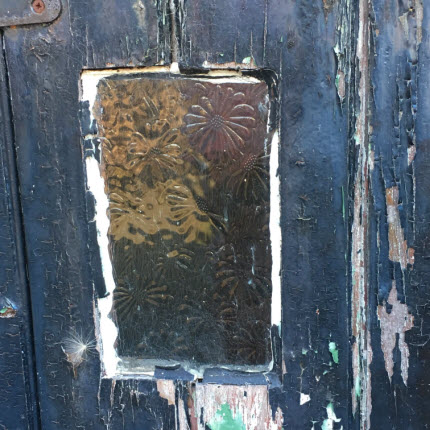 Paint that has begun to crack and peel
Paint that has begun to crack and peel
The Glory of Going the Wood Stain Route
In contrast to paint, shed stains are a much thinner liquid and are formulated to soak in to the wood. They contain some pigment which impart a particular colour to the wood, but the features of the wood such as the grain and knots are still visible.
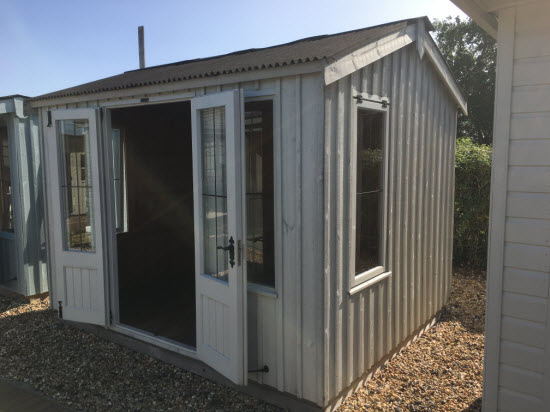 Nice looking shed protected with woodstain
Nice looking shed protected with woodstain
The benefit of the stain soaking into the wood is that it becomes part of the wood and moves with it so that cracks don't form. Also, the stain finish is what is known as 'microporous' which means that it will allow moisture to escape from the wood through the finish. This avoids the decay problem that occurs with paint.
Downsides of Exterior Wood Stain
However, wood stain isn't a magic bullet it does have some areas where it doesn't perform as well as paint. The water protection provided by stains is a waxy layer on the wood surface that does a great job of repelling water. This layer is gradually abraded by the impact of uv light and rain. So what starts off as a great water repellent surface is gradually eroded. This means that you will most likely need more frequent applications of stain than paint.
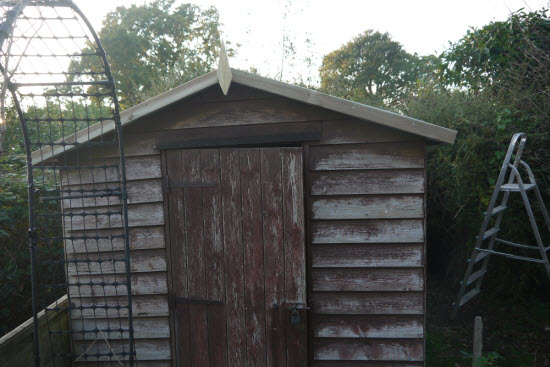 Woodstain eventually weathers away. This one has been left far too long!
Woodstain eventually weathers away. This one has been left far too long!
Traditionally, the colour choices with stains aren't as broad as with paint, however this downside is much less than it used to be with systems such as the Sadolin brand offering a broad range of colours. Not just the traditional shades of brown that used to be on offer!
The Cost Factor: Paint vs Wood Stain
Money talks and in this case, the conversation is interesting. Paint can give your wallet a harder hit initially due to the cost per can and the number of layers needed for that perfect finish.
On the other side, though initially milder on your finances, exterior wood stain might end up being the costlier route in the long run due to more frequent re-applications.
Durability: Paint versus Exterior Wood Stain
Durability figures high on the list of considerations when deciding between paint and wood stain.
Quality paint, under favourable conditions, promises years of service before requiring a touch-up. However, if it isn't perfectly applied and you get the splits or cracking referred to earlier then the damage to the underlying wood due to decay can require extensive repair.
The lifespan of the wood stain can be variable, heavily dependent on exposure to weather variations and the quality of the initial application. I often see this when inspecting sheds for repair. Where one side is more exposed to sun and rain, the surface protection provided by the stain is almost worn off. However, on other more sheltered faces of the shed the stain is still in almost perfect condition.
Application: Paint vs Wood Stain
No matter the choice, the perfect finish requires patience and precision. And also, a bit of timing as to the time of the year, the weather needs to be relatively warm and dry. The weather should have been dry for a while so that you are painting on to a nice dry substrate. It should also be forecast to be dry for a while to give the coating a chance to 'dry' and become ready to receive subsequent applications.
The time between coats is important. It is important that each coat is properly dried to ensure that the next coat can adhere to it and complete the coating process as the product was designed. So that you will get the life that you want from the product that you are applying.
Applying paint, will need a preparatory session including tasks like sanding and priming before paint meets wood.
Whereas applying stain requires less preparation, a good clean with a stiff brush to remove any cobwebs and surface debris. Then a careful hand, and time for at least two coats.
Weather Impact: Paint vs Wood Stain
The climate plays its part in deciding between paint and stain as well.
The harshness of external climate factors, including sun and rain, can significantly impact painted wood. Prolonged sun exposure can cause paint to fade and lose its original color, while heavy or consistent rainfall can lead to the paint peeling or chipping away, leaving the wood exposed and vulnerable to decay and rot.
In contrast, exterior wood stain adapts well to varying climates as it has been absorbed into the surface of the wood. But extended sun exposure will lead to the gradual fading of the stain's color, and consistent, heavy rainfall may result in the stain being washed out over time, decreasing the effectiveness of its protective qualities.
Maintenance and Upkeep: Paint versus Wood Stain
Maintaining a paint finish on external timber involves regularly checking for signs of wear and tear, such as peeling or chipping paint, and promptly addressing these issues with touch-ups or a fresh coat of paint. Moreover, gentle cleaning with a soft brush and soapy water can help preserve the paint's appearance, removing dirt and preventing the build-up of grime.
Maintaining a stain finish on external timber primarily involves annual inspections to detect early signs of colour fading or damage. A test that is easy to apply is the beading of water. When water beads on the surface as in the attached picture then the stain is working to protect the wood from moisture. When water doesn't bead and spreads out on the surface or even soaks in then it is time for a re-application of stain.
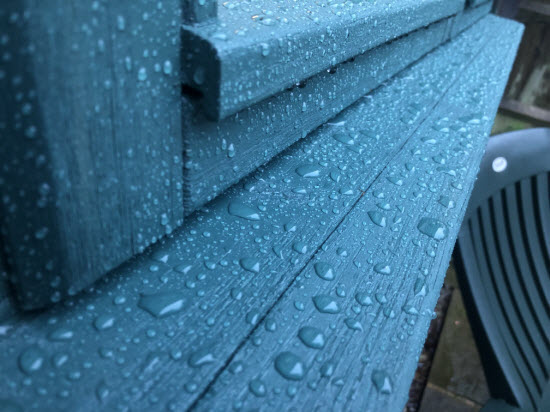 Water beading on a recently stained window sill
Water beading on a recently stained window sill
In terms of maintenance if you have time gently clean the timber surface periodically to remove any dust, dirt, or mildew. By preventing this build-up of grime, you remove some of the abrasive material which can prematurely wear down the stain.
Environmental Impact: Paint and Wood Stain
Finally, your choice of wood finish will have an environmental impact.
The process of paint manufacturing can result in environmental harm, as it often involves the release of volatile organic compounds (VOCs) into the air, contributing to air pollution.
In contrast many wood stain manufacturers are now producing low-VOC or VOC-free alternatives and using more environmentally friendly ingredients to help reduce this impact. These more environmentally-friendly ingredients in wood stains, include natural oils such as linseed or tung oil, along with plant-derived dyes or minerals for coloration. In addition, some manufacturers use constituents like beeswax or carnauba wax to increase durability and resistance. The solvents used are often derived from citrus or other plant sources rather than harsh chemicals, which helps to keep VOC levels low.
Conclusion
In my view both shed paint and stain have a place in timber protection.
For large surface areas such as walls and cladding stain is the way to go. There is minimal preparation for initial applications and for subsequent applications there is none of the sanding and application of a primer. Just give the surface a good brush down with a stiff brush and apply as many coats as are required.
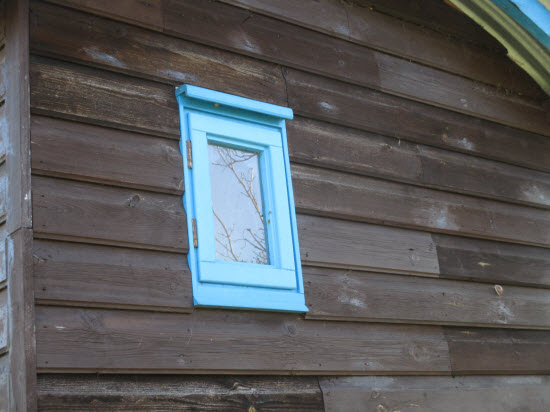 Stain used for walls and paint used for the joinery made windows
Stain used for walls and paint used for the joinery made windows
In my view paint has its place on garden buildings for window frames or joinery made doors. These areas are much smaller and easier to maintain and they are also seen more close up. So you can spot as and when they need some TLC for repainting.
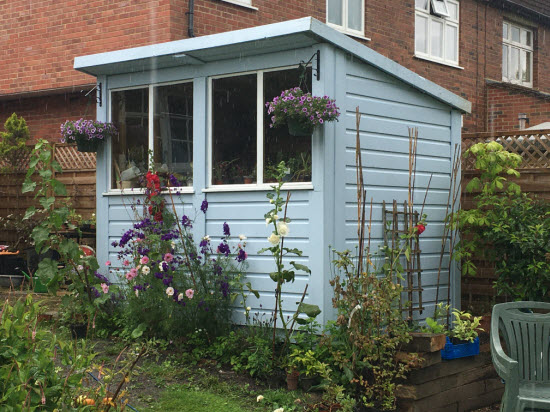 Nicely finished shed. Paint on the window surrounds stain on the rest of the shed
Nicely finished shed. Paint on the window surrounds stain on the rest of the shed

Keep in touch with our monthly newsletter
Shed Building Monthly




